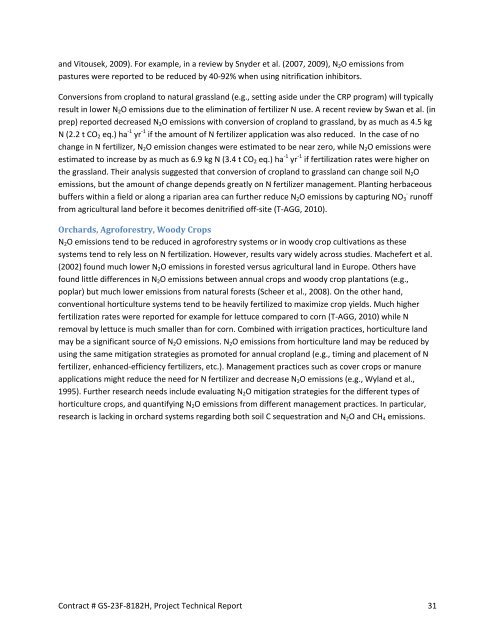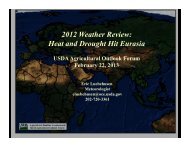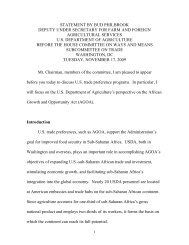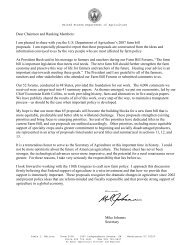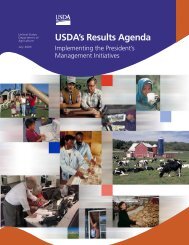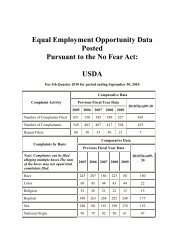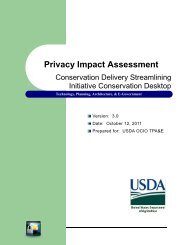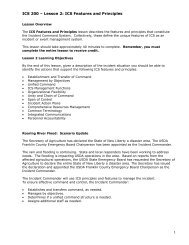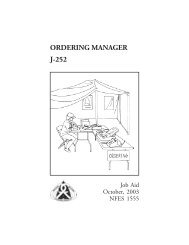Greenhouse Gas Emissions from U.S. Agriculture and Forestry: A ...
Greenhouse Gas Emissions from U.S. Agriculture and Forestry: A ...
Greenhouse Gas Emissions from U.S. Agriculture and Forestry: A ...
You also want an ePaper? Increase the reach of your titles
YUMPU automatically turns print PDFs into web optimized ePapers that Google loves.
<strong>and</strong> Vitousek, 2009). For example, in a review by Snyder et al. (2007, 2009), N2O emissions <strong>from</strong><br />
pastures were reported to be reduced by 40‐92% when using nitrification inhibitors.<br />
Conversions <strong>from</strong> cropl<strong>and</strong> to natural grassl<strong>and</strong> (e.g., setting aside under the CRP program) will typically<br />
result in lower N2O emissions due to the elimination of fertilizer N use. A recent review by Swan et al. (in<br />
prep) reported decreased N2O emissions with conversion of cropl<strong>and</strong> to grassl<strong>and</strong>, by as much as 4.5 kg<br />
N (2.2 t CO2 eq.) ha ‐1 yr ‐1 if the amount of N fertilizer application was also reduced. In the case of no<br />
change in N fertilizer, N2O emission changes were estimated to be near zero, while N2O emissions were<br />
estimated to increase by as much as 6.9 kg N (3.4 t CO2 eq.) ha ‐1 yr ‐1 if fertilization rates were higher on<br />
the grassl<strong>and</strong>. Their analysis suggested that conversion of cropl<strong>and</strong> to grassl<strong>and</strong> can change soil N2O<br />
emissions, but the amount of change depends greatly on N fertilizer management. Planting herbaceous<br />
buffers within a field or along a riparian area can further reduce N2O emissions by capturing NO3 ‐ runoff<br />
<strong>from</strong> agricultural l<strong>and</strong> before it becomes denitrified off‐site (T‐AGG, 2010).<br />
Orchards, Agroforestry, Woody Crops<br />
N2O emissions tend to be reduced in agroforestry systems or in woody crop cultivations as these<br />
systems tend to rely less on N fertilization. However, results vary widely across studies. Machefert et al.<br />
(2002) found much lower N2O emissions in forested versus agricultural l<strong>and</strong> in Europe. Others have<br />
found little differences in N2O emissions between annual crops <strong>and</strong> woody crop plantations (e.g.,<br />
poplar) but much lower emissions <strong>from</strong> natural forests (Scheer et al., 2008). On the other h<strong>and</strong>,<br />
conventional horticulture systems tend to be heavily fertilized to maximize crop yields. Much higher<br />
fertilization rates were reported for example for lettuce compared to corn (T‐AGG, 2010) while N<br />
removal by lettuce is much smaller than for corn. Combined with irrigation practices, horticulture l<strong>and</strong><br />
may be a significant source of N2O emissions. N2O emissions <strong>from</strong> horticulture l<strong>and</strong> may be reduced by<br />
using the same mitigation strategies as promoted for annual cropl<strong>and</strong> (e.g., timing <strong>and</strong> placement of N<br />
fertilizer, enhanced‐efficiency fertilizers, etc.). Management practices such as cover crops or manure<br />
applications might reduce the need for N fertilizer <strong>and</strong> decrease N2O emissions (e.g., Wyl<strong>and</strong> et al.,<br />
1995). Further research needs include evaluating N2O mitigation strategies for the different types of<br />
horticulture crops, <strong>and</strong> quantifying N2O emissions <strong>from</strong> different management practices. In particular,<br />
research is lacking in orchard systems regarding both soil C sequestration <strong>and</strong> N2O <strong>and</strong> CH4 emissions.<br />
Contract # GS‐23F‐8182H, Project Technical Report 31


